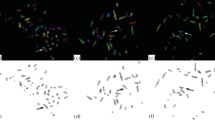Summary
The biological features of a stable cell strain LHC-105 derived from a spontaneous abortus are reported.
Giemsa T-staining revealed that the extra chromosome in the karyotype of the strain was chromosome No. 14 (47,XY,+14). The 14th chromosomes participated in acrocentric association more frequently than expected.
The cells of the strain appeared to have a low growth potential, with low cell yield during serial passages throughout their life-span which is considerably shorter than the life-span of the diploid strains.
The cells differed from the diploid ones in their peculiarity of growth, and were also less orientiated. They did not form elementary histotypical structures, revealed considerable changes in their morphology and cellular size, and differences state fibrillar structure and nucleoli.
The LHC-105 cells showed a number of metabolic disturbances, including a poor accumulation of lipid droplets, a strong positive PAS reaction to polysaccharides, a low activity of acid and alkaline phosphatases. The cell cycle was normal.
The relation between these phenotypic alterations and the chromosome aberration is discussed. The possibility of a cellular syndrome connected with trisomy is also considered. It is suggested that the changes in cellular phenotype of LHC-105 cells are connected with a disturbance of differentiation and embryogenesis.
Zusammenfassung
Die biologischen Eigenschaften des stabilen Zellstammes LHC-105 von einem spontanen Abortus werden beschrieben. Die Längsdifferenzierung der Chromosomen mit Giemsa-Technik und Trypsinbehandlung hat gezeigt, daß der Karyotyp aus 47 Chromosomen besteht. Das überzählige Chromosom wurde als Nr. 14 identifiziert. Das Studium der Assoziationen akrozentrischer Chromosomen hat gezeigt, daß die Chromosomen 14 häufiger an Assoziationen teilnehmen als erwartet. Die Zellen haben eine niedrigere Wachstumspotenz als diploide Fibroblasten. Außerdem zeigen sie einige Besonderheiten des Wachstums. Sie sind wenig orientiert, bilden keine elementaren histotypischen Strukturen und zeigen starke Veränderungen ihrer Morphologie (Zellgröße, Zustände von fibrillären Strukturen und Nucleolus). Es wurde gezeigt, daß diese Zellen auch eine Reihe von metabolischen Veränderungen aufweisen: wenig Einschließungen von Lipiden, starke Schiff-Reaktion, niedrige Aktivität der sauren und alkalischen Phosphatasen. Der Zellcyclus ist normal. Der Zusammenhang dieser phenotypischen Veränderungen mit der Chromosomenanomalie und die Möglichkeit einer Existenz spezifischer Zellsyndrome mit Trisomie werden diskutiert. Es wird angenommen, daß Veränderungen des Zellphenotyps des Stammes LHC-105 mit Störungen der Zelldifferenzierung verbunden sind und Ursache der abnormalen Embryogenese sind.
Similar content being viewed by others
References
Capoa, A. de, Rocchi, A., Gigliani, F.: Frequency of satellite associations in individuals with structural abnormalities of nucleolus organizer region. Humangenetik 18, 111 (1973)
Conrad, G. W., Sherman, D., Dortman, A.: An ultrastructural comparison of normal and Hurler syndrome dermal fibroblasts. Pediat. Res. 6, 533 (1972)
Haenel, U.: Veränderungen der Nucleolarsubstanz an Knochenmarkzellen bei pernicioser Anämie und ihre pathogenetische Bedeutung. Helv. med. Acta 17, 627 (1950)
Kajii, T., Ohama, K., Ferrier, A.: Trisomy 14 in spontaneous abortus. Humangenetik 15, 265 (1972)
Kajii, T., Ohama, K., Niikawa, N., Ferrier, A., Avirachan, S.: Banding analysis of abnormal karyotypes in spontaneous abortion. Amer. J. hum Genet. (in press, 1973)
Kelly, T. L., Nielson, E. D., Jonson, R. B., Vestling, C. S.: Glucose-6-phosphate dehydrogenase of adrenal tissue. J. biol. Chem. 212, 545 (1955)
Kuliev, A. M.: Cytogenetic investigation of spontaneous abortions. Humangenetik 12, 275 (1971)
Kuliev, A. M., Grinberg, K. N., Vasileysky, S. S., Stepanova, L. G., Urovskaya, G. B.: Human cell strains with chromosome aberrations (cytogenetical, morphological, and immunochemical studies) (Russ.). Genetics (Moscow) 8, 146 (1972)
Kuliev, A. M., Kukharenko, V. I., Grinberg, K. N., Vasileysky, S. S., Terskikh, V. V., Stepanova, L.G.: Morphological, autoradiographic, immunochemical, and cytochemical investigation of a cell strain with trisomy 7 from a spontaneous abortus. Humangenetik 17, 285 (1973)
Lauritsen, J. G., Jonasson, J., Therkelsen, A. J., Lass, F., Lidsten, J., Petersen, G. B.: Studies of spontaneous abortions. Fluorescence analysis of abnormalkaryotypes. Hereditas (Lund) 71, 160 (1972)
Lacas, M., Wallace, I., Hirschborn, K.: Recurrent abortions and chromosome abnormalities. J. Obstet. Gynaec. Brit. Cwlth 79, 1119 (1972)
Levin, S., Hahn, T.: Transformation of cells in culture from children with chromosomal and immune deficiency disorders. Israel J. med. Sci. 8, 133 (1972)
Meritt, A. P., Tomkins, G. M.: Reversible oxidation of cyclic secondary alcohols by liver alcohol dehydrogenase. J. biol. Chem. 234, 2778 (1959)
Ochoa, S.: Malat dehydrogenase from pig heart. Meth. Enzymol. 1, 735 (1955)
Ottolenghi, P., Denstedt, O.: Mechanism of action of the lactat dehydrogenase of the mammalian erythrocytes. Canad. J. Biochem. 36, 1075 (1958)
Parslow, M. I., Gardner, R. S. M., Veale, A. M. O.: Giemsa banding in the t(13q13q) carrier mother of a translocation trisomy 13 abortus. Humangenetik 18, 149 (1973)
Petersen, G. B., Therkelsen, A. I.: Number of nucleoli in female and male human cells in tissue culture. Exp. Cell Res. 28, 590 (1962)
Prokofieva-Belgovskaya, A. A., Gindilis, V. M., Grinberg, K. N., Bogomazov, E. A., Podugolnikova, O. A., Isaeva, I. I., Radjabli, S. I., Cellarius, S. Ph., Veschneva, I. V.: Association of acrocentric chromosomes in relation to cell type and age of individuals. Exp. Cell Res. 49, 612 (1968)
Author information
Authors and Affiliations
Additional information
The work was supported by research Grants HG-70/9684148 from Human Genetics Unit WHO.
Rights and permissions
About this article
Cite this article
Kuliev, A.M., Kukharenko, V.I., Grinberg, K.N. et al. Investigation of a cell strain with trisomy 14 from a spontaneously aborted human fetus. Hum Genet 21, 1–12 (1974). https://doi.org/10.1007/BF00278558
Received:
Published:
Issue Date:
DOI: https://doi.org/10.1007/BF00278558




